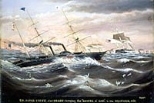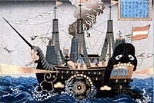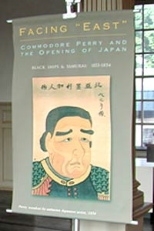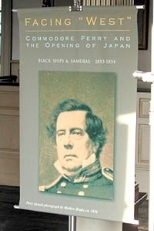Two MIT professors--a Pulitzer Prize-winning historian and a linguist named one of 20 national "Shapers of the Future"--have designed an innovative exhibit to honor the 150th anniversary of Commodore Matthew Perry's 1853 journey to Japan and the 20th annual Black Ships Festival in Perry's hometown of Newport, R.I.
"Facing 'East,' Facing 'West': Commodore Perry and the Opening of Japan" juxtaposes Japanese graphics depicting Perry's arrival with images depicting the same encounter through American eyes.
Created by John Dower, the Elting T. Morison Professor of History at MIT, and Shigeru Miyagawa, professor of lingustics and the Kochi-Manjiro Professor of Japanese Language and Culture, the new exhibit runs from July 17-27 at the Colony House in Newport. It is co-sponsored by MIT, the Consulate General of Japan in Boston, and Newport Historical Society.
Dower won the Pulitzer Prize in 2000 for "Embracing Defeat," a study of post-World War II Japan. Miyagawa is the creator of StarFestival, a digital curriculum on Japanese culture and history, and winner of numerous awards for his pioneering work in educational technology. The new exhibit was inspired by a course created by Dower and Miyagawa as part of MIT OpenCourseWare (MIT OCW), an initiative that is focused on the publication of the course materials from virtually all 2,000 of MIT's courses over the next several years.
Dower will deliver a lecture on the Perry mission and the evolution of the exhibit at the Newport Art Museum on Friday, July 18 at 3 p.m.
Perry is credited with opening a secluded, feudal Japan to trade with the United States. The term "black ships" comes from the name Japanese gave to Perry's gunboats, several of which were coal-burning steamships never before seen in Japan.
"This is a little gem of an exhibition, a wonderful, innovative way to illustrate the complexity of differences in esthetics and entertainment values between Americans and Japanese--people who were deeply curious about each other," Dower said. "One pair of images that gives a stunning sense of 'same but different' is the official American portrait of Perry's steamship, charged with 'Carrying God and Gospel to the Heathen.' It hangs opposite a Japanese imaginary portrait showing Perry's ship as demonic. It's immediately clear: one person's God is another person's demon."
The materials in "Facing 'East,' Facing 'West'" include two scrolls owned by the Newport Naval Historical Center; two Newport Historical Society lithographs by William Heine, the young German artist who documented Perry's mission, and a 30-foot horizontal scroll digitally displayed on a large-scale plasma screen. The scroll is essentially a Japanese record of Americans in their midst, a kind of 19th-century "On the Town."
"The scroll is entertaining and very, very witty, especially in contrast with the sober, official American graphics. The Japanese graphics were done by scores of people and were widely distributed, almost like tabloids," said Dower.
The exhibit was designed to be accessible to viewers and to meet criteria of historic preservation in the Colony House itself, such as not hanging anything on the walls.
Once again, MIT expertise and innovativeness came through, in the persons of alumna Ellen Sebring (S.B. 1986) and her colleague, Scott Shunk.
"The exhibition is a balance between art and information. Printed on soft material, the large reproductions have a gentle movement and can be rolled like scrolls for travel. Digital animations allow viewers to see details not viewable in any other way. Text is interwoven throughout. With these insights, viewers will experience the original artworks on display in a new light," Sebring said.
Shunk added, "The suspension method leaves the historic building unscathed while highlighting its dramatic height."
"Facing 'East,' Facing 'West'" was inspired by "Visualizing Cultures," an MIT OCW course web site created by Dower and Miyagawa. MIT OCW will publish 500 courses by September 2003, enabling visitors to ocw.mit.edu access to the courses from all five MIT schools, and all 33 of MIT's academic departments, programs, and divisions.
"Learning technologies are only as good as the quality of the digital material made available to the learners. Our project, and the exhibit as part of it, is intended to provide an example of how some of the very best materials in a society can be made freely available. We're pleased that many museums and other institutions with important collections have given permission for us to include their material in our OCW site and in the exhibition," said Miyagawa.
Miyagawa has been involved with MIT OCW since its launch in 2000, and serves as a member of the MIT OCW Faculty Advisory Committee. Of the exhibit and the new course, he said, "We designed the web material from ground up within the OCW infrastructure, and the OCW team has been extremely helpful throughout. Creating our site within OCW brought an extra layer of discipline both in design and also in selection of graphics."
For more information about the exhibition, contact Motoyo Koyata at the Consulate General of Japan in Boston at 617-973-9772 ext.129, or go to http://www.newporthistorical.org/perry.htm.
The Dower-Miyagawa project, which includes the web site, the Newport exhibition and the new course, "Visualizing Cultures," has been funded by the d'Arbeloff Fund for Excellence in Education.
For additional information on MIT OCW, visit the web site or contact Jon Paul Potts, Communications Manager, at 617-452-3621 or jpotts@mit.edu.









